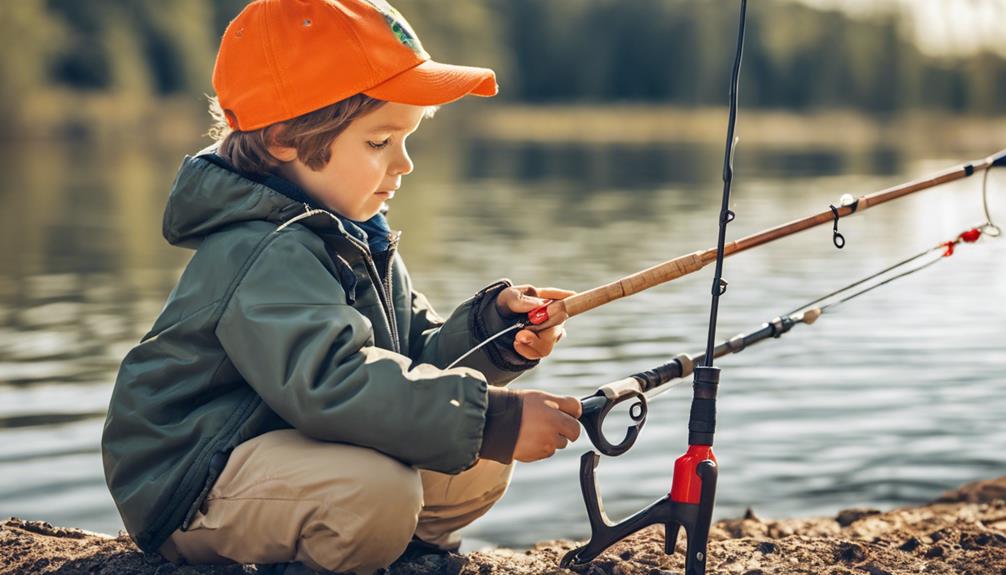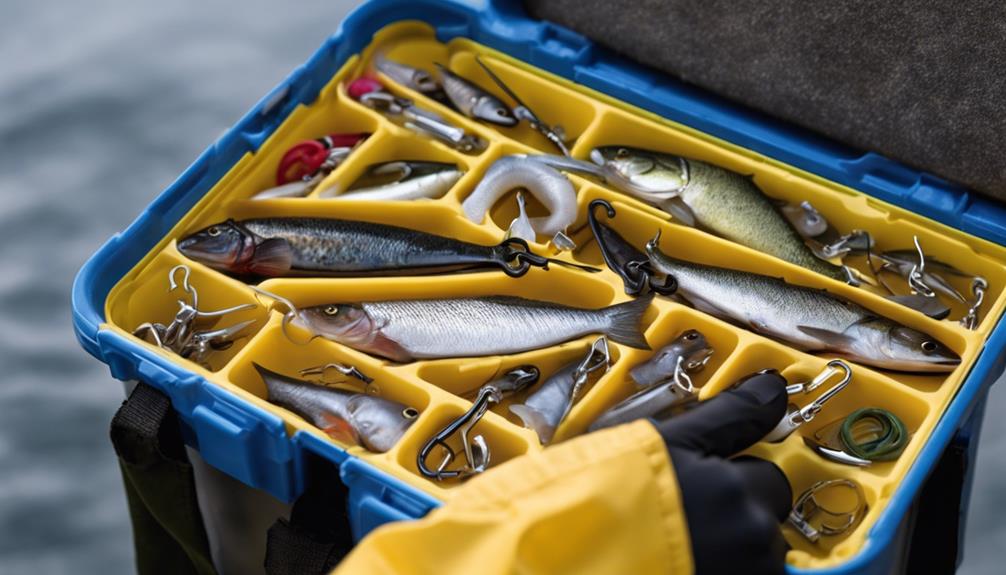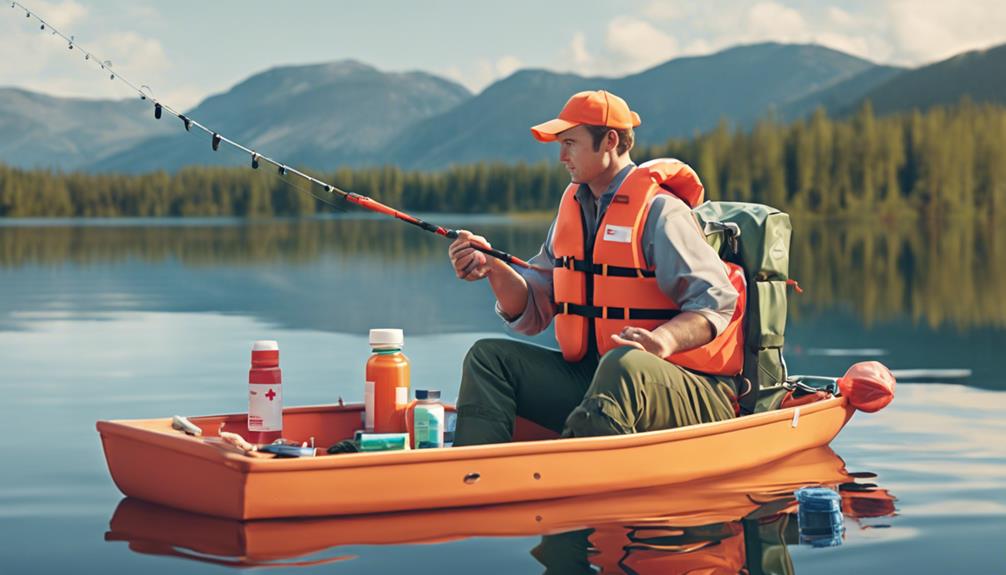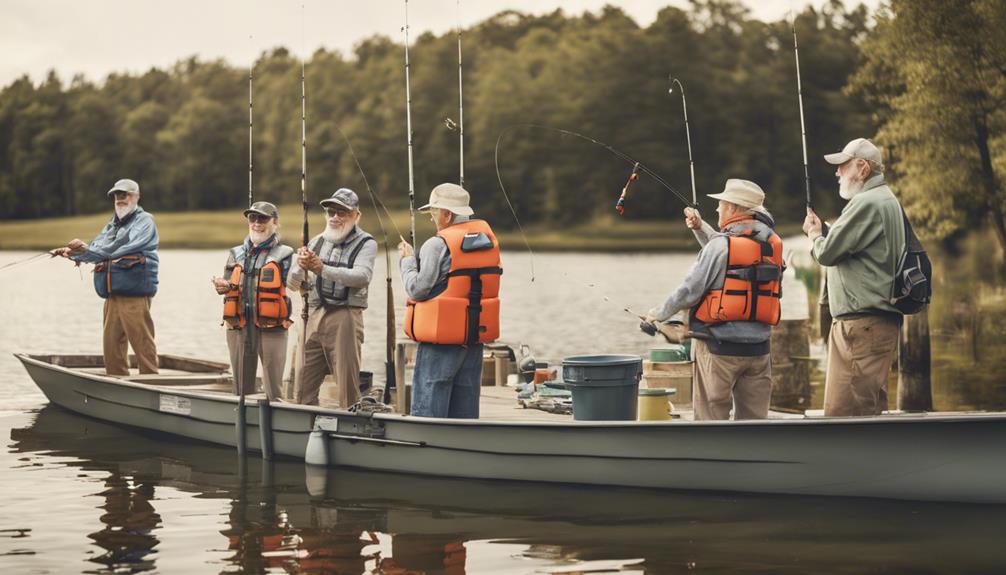Ensuring proper fishing hook safety is paramount for every angler. From the shimmering streams to the vast ocean waters, the risk of hook-related accidents looms ominously.
But why is this aspect of fishing gear maintenance so crucial? The consequences of neglecting hook safety can be more than just a minor inconvenience; they can lead to serious injuries and even life-threatening situations.
It's essential to grasp the significance of this fundamental aspect of angling to safeguard not only your own well-being but also that of your fellow fishing enthusiasts.
Importance of Hook Safety
Understanding the significance of hook safety is crucial for every angler, ensuring a smooth and accident-free fishing experience. Preventing accidents should be a top priority when out on the water. By educating yourself on proper hook safety measures and raising awareness among fellow anglers, you can significantly reduce the risk of injuries and mishaps while enjoying your favorite pastime.
Accidents involving fishing hooks can happen in the blink of an eye, but with the right knowledge and precautions, many of these incidents can be avoided. One of the most basic yet essential aspects of hook safety is being mindful of your surroundings. Always make sure there's enough space between you and others when casting your line to prevent accidental hooking. Additionally, keeping your hooks covered when not in use can prevent unintended injuries.
Education and awareness play a pivotal role in promoting hook safety among anglers of all levels. Knowing how to properly handle, store, and dispose of hooks can make a significant difference in preventing accidents. Take the time to familiarize yourself with different types of hooks and their specific uses, as this knowledge can help you choose the right hook for the job and minimize risks.
Types of Fishing Hooks
When it comes to fishing, knowing the different types of hooks available can help you choose the right one for your specific needs and improve your overall fishing experience. Hooks come in various sizes and are made from different materials to cater to the diverse requirements of anglers.
Different hook sizes are suitable for various fish species and fishing techniques. Smaller hooks are ideal for catching panfish or trout, while larger hooks are better suited for bigger fish like catfish or bass. It's essential to match the hook size to the type of fish you're targeting to ensure a successful catch.
Hook materials also play a crucial role in determining the hook's strength, sharpness, and durability. Common hook materials include stainless steel, carbon steel, and high-carbon steel. Stainless steel hooks are corrosion-resistant, making them suitable for saltwater fishing. Carbon steel hooks are strong and durable, making them ideal for freshwater fishing. High-carbon steel hooks are known for their sharpness and are excellent for catching fish with tough mouths.
Proper Hook Removal Techniques
To safely remove a fishing hook from a fish or yourself, follow these proper techniques for a successful and injury-free extraction. When it comes to hook removal, prevention is key. Always handle hooks with caution to avoid accidental pricks. If a fish swallows the hook deeply, consider cutting the line and releasing the fish with the hook still embedded to prevent causing further harm. For your safety, never yank a deeply embedded hook as it can lead to more damage.
Safety precautions are essential during hook removal. Start by calming the fish if it's still on the line to minimize its movements. For your own injuries, assess the hook's location and angle of entry before attempting removal. If the hook is in a sensitive area or near vital organs, seek medical help instead of trying to remove it yourself. Additionally, always wear protective gloves to reduce the risk of getting hooked.
In cases where the hook is only superficially embedded, you can remove it by pushing the hook through until the barb is free, then carefully backing it out the way it came. After hook removal, clean the wound thoroughly and apply antiseptic to prevent infections. Remember, if you find yourself struggling or in pain during the process, seek professional medical assistance promptly.
Using Barbless Hooks
Consider using barbless hooks for a safer and more efficient fishing experience. Barbless hooks are designed without the traditional barb that protrudes backward from the point, making them easier to remove from both fish and your own skin. When practicing catch and release, using barbless hooks can significantly reduce harm to the fish. The lack of a barb makes hook removal quicker and gentler, increasing the chances of the fish surviving upon release.
Hook removal becomes a simpler task with barbless hooks, as there's no barb to cause further damage when taking the hook out of the fish's mouth. This feature is especially beneficial when dealing with deeply hooked fish, as it minimizes injury and stress. Additionally, in the unfortunate event that you accidentally hook yourself, barbless hooks are easier and less painful to remove, reducing the risk of infection and speeding up the extraction process.
Securing Hooks During Transport
Securing hooks during transport ensures safety for both your gear and yourself when moving between fishing spots. It's crucial to prevent accidents or injuries caused by loose hooks. One effective way to secure hooks during transport is by using dedicated storage solutions designed for this purpose.
Investing in tackle boxes with specialized compartments for hooks can help keep them organized and secure. These boxes typically have individual slots or containers where you can safely store each hook, preventing them from tangling with other gear or pricking you accidentally. Additionally, using magnetic hook holders or hook covers can add an extra layer of protection. These tools help keep the hooks in place and shielded, reducing the risk of unwanted incidents.
When transporting fishing rods with hooks attached, make sure to cover the hooks with protective caps or sheaths. This simple step can prevent hooks from snagging onto clothing, gear, or even yourself. It's also advisable to double-check that all hooks are safely stored and secured before moving to a new fishing location.
Storing Hooks Safely
Properly storing hooks is essential for maintaining fishing equipment and preventing accidents. When hooks are left loose or disorganized, they can pose a risk not only to you but also to others around you. Here are some tips to help you store your hooks safely and keep your tackle box organized:
- Use Hook Organizers: Invest in small compartment tackle boxes or hook organizers to keep different types and sizes of hooks separate. This will prevent them from tangling and making it easier to find the right hook when needed.
- Cover Sharp Ends: For added safety, consider using hook bonnets or covers to protect the sharp ends of the hooks. This will reduce the risk of accidental pricks or cuts when reaching into your tackle box.
- Store Hooks Dry: Moisture can lead to rust and corrosion on hooks, compromising their strength and sharpness. Ensure your hooks are completely dry before storing them in your tackle box to prevent damage.
- Secure Your Tackle Box: When transporting your tackle box, make sure it's securely closed to prevent hooks from spilling out and causing accidents. A sturdy latch or lock can help keep everything contained and safe.
Teaching Hook Safety to Children

To ensure children learn how to handle fishing hooks safely, emphasize the importance of proper handling techniques from an early age. Child supervision is crucial when teaching kids about hook safety. Always educate them on the potential dangers of hooks and the importance of using safety precautions. Start by showing them how to hold a hook properly, emphasizing that the sharp end should always be facing down and away from their body. Teach them how to handle hooks with care, ensuring they understand that hooks aren't toys and should only be used for fishing purposes.
When discussing hook education with children, make sure they're aware of the risks involved if hooks aren't handled correctly. Explain that hooks can easily cause injuries if mishandled or carelessly left lying around. Encourage them to ask questions and seek guidance whenever they're unsure about hook handling. Additionally, demonstrate how to safely remove a hook from a fish or an object, emphasizing the need to do it carefully to avoid accidents.
Supervising children while they practice handling hooks is essential for their safety. By instilling good hook safety habits early on, you're helping them develop a lifelong respect for fishing equipment and promoting a safe fishing experience for everyone. Remember, proper hook safety starts with education and consistent reinforcement of safety guidelines.
Emergency Response for Hook Injuries
In case of a fishing hook injury, swiftly assess the situation before proceeding with any removal attempts. First aid is crucial to prevent further damage and ensure a smooth recovery process.
Here are some essential steps to follow in handling a hook injury:
- Assess the Injury: Before taking any action, determine the severity of the hook penetration and if any surrounding structures are affected.
- Control Bleeding: Apply pressure around the wound to stop or minimize bleeding. Avoid removing the hook if it's acting as a plug to control bleeding.
- Seek Professional Help: If the injury is severe, seek medical attention immediately. A healthcare provider can safely remove the hook and provide proper wound care.
- Prevent Infection: Keep the wound clean and covered to reduce the risk of infection. Proper wound care is essential for a successful healing process.
Frequently Asked Questions
Are There Any Regulations or Laws Regarding Fishing Hook Safety That Anglers Should Be Aware Of?
When you're out fishing, it's crucial to be aware of safety regulations and laws related to hook safety.
Angler education is key to understanding proper hook removal techniques and emergency procedures.
Make sure to familiarize yourself with any regulations in your area to ensure you're following the rules and keeping yourself and others safe while enjoying your fishing adventures.
How Often Should Fishing Hooks Be Replaced or Inspected for Damage?
Inspect your fishing hooks regularly to ensure they're in good condition. Make it a habit to check for any signs of damage or wear, such as rust or dullness.
As a general rule, consider replacing your hooks every few trips or if they show any signs of wear and tear. Proper hook maintenance is crucial for a successful and safe fishing experience.
Can Fishing Hooks Be Recycled or Disposed of in an Environmentally-Friendly Manner?
When it comes to fishing hooks, it's important to know that they can be recycled or disposed of in an environmentally-friendly manner. Recycling options and eco-friendly disposal methods are key for reducing the impact on the environment.
Are There Any Specialized Tools or Equipment That Can Help Prevent Hook Injuries While Fishing?
When you're out fishing, safety precautions are crucial to prevent injuries. There are specialized gear options available that can help reduce the risk of hook-related accidents.
Tools like barbless hooks, hook removers, and protective covers can make your fishing experience safer and more enjoyable. By incorporating these injury prevention measures into your fishing routine, you can significantly decrease the chances of hook-related mishaps.
What Should Anglers Do if They Accidentally Swallow a Fishing Hook While Fishing?
If you accidentally swallow a fishing hook while fishing, remember to stay calm.
Immediately seek First Aid and Emergency Response assistance.
Don't try to remove the hook yourself as it may cause further damage.
Medical professionals can safely handle the situation and prevent complications.
It's crucial to act swiftly and prioritize your well-being in such situations.
Conclusion
In conclusion, proper fishing hook safety is crucial to prevent accidents and injuries while enjoying your time on the water.
By using the right techniques for hook removal, choosing barbless hooks, and securely storing your equipment, you can greatly reduce the risk of harm to yourself and others.
Remember to always prioritize safety when fishing to ensure a fun and accident-free experience.



